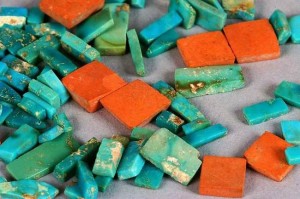 Green turquoise color is highly sought after when you are looking for stones from mines in the Southwestern United States.
Green turquoise color is highly sought after when you are looking for stones from mines in the Southwestern United States.
Stones with a green turquoise color primarily come from Nevada mines, where the composition of elements in the ground, produce turquoise with a green tint.
Why is Green Turquoise Color More Popular in the United States
Green turquoise color is actually considered a flaw in some other countries and American collectors seem to put a much higher value on these stones. This is not only because of the strikingly beautiful color, but because many of the mines that were once producing turquoise have depleted in supply and ceased operation. A common feature in stones with a green turquoise color is the matrix – also described as webbing. The matrix is made of the host rock and adds depth and complexity to turquoise stones.The color of the matrix may vary and could be brown, black or even copper in color – depending on how the green turquoise formed in the rock.
The science behind green turquoise color
Geologists have attributed the green turquoise coloration to a number of factors, including the levels of certain minerals that form turquoise, such as copper, phosphate, and aluminum. Green turquoise is also the result of formation in an arid environment. The primary reason turquoise doesn’t form is wetter climates is because rain and moisture will wash out the compounds that together, form stones of green turquoise.
Green turquoise stones are available through retailers and mining operations. There are still beautiful examples of green turquoise jewelry being made and sold on the market and green turquoise is also used in artwork and other crafts.
While Nevada may be the main producer of green turquoise, shades of green turquoise color can be found from mines in Arizona and other parts of the Southwest. If you look hard enough, you’ll surely be able to get your hands on some green turquoise color.
